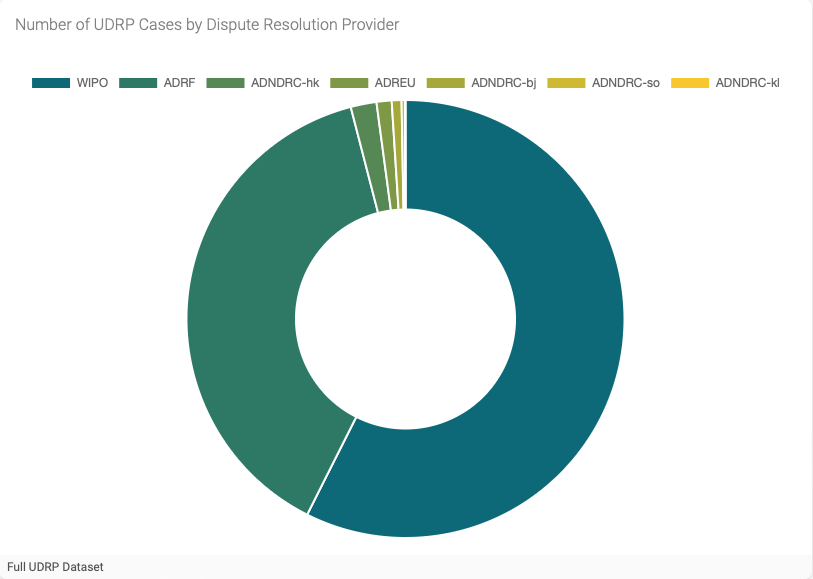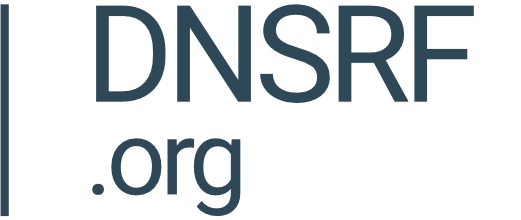Domain Name Disputes: large scale text analysis tells the UDRP story

By Alex Deacon
This article delves into an uncommon dataset hosted on the DNS Research Federation's DAP.LIVE platform, focusing on information related to the ICANN Uniform Domain Name Dispute Resolution Policy (UDRP) decisions. Our collection of UDRP decisions across four dispute resolution providers is one of a few that exist. The DAP’s large-scale text analysis capabilities enable us to convert unstructured data from multiple sources into a structured and normalized format suitable for analysis that includes approximately 83,000 individual cases, encompassing 156,000 domain names.
We used this dataset to find that WIPO administered 57% of the UDRP cases, followed by The ADR Forum at 39%. The decisions in the dataset contain an average of 1.88 domain names, although some decisions involve thousands of domain names. Notably, only 44% of decisions cited a single domain name, indicating that URDP complainants look for economies of scale where possible. In addition, the top 10 complainants in the sample are multinational organizations with numerous consumer brands, including Philip Morris, Lego, Michelin, and Hoffmann-La Roche.
Introducing the UDRP Decision Feeds
We create the data feeds on the DNS Research Federations DAP.LIVE platform using a combination of one or more raw data sources. The DNSRF team curates and de-duplicates each feed to enable easy analysis. As of the writing of the blog, the DAP hosts 71 different data feeds that span 17 categories. You can visit the DAP Data Feeds page to learn more about each data feed and the categories currently available. We obtain the data hosted by the DAP from various sources and providers, including publicly available (e.g., zone file data, blockchain data) and commercial data sources (e.g., abuse data from Spamhaus, URLhaus, and passive DNS data).
The subject of this blog is the numerous feeds that contain data from decisions associated with the ICANN Uniform Domain Name Dispute Resolution Policy, more commonly known as the UDRP. The UDRP is a process used to resolve disputes regarding the registration of domain names, especially those involving registered trademarks. Dispute Resolution Service Providers, accredited by ICANN, adjudicate UDRP cases. Each provider makes the final decision for each UDRP case available to the public. The UDRP data in the DAP is uncommon, we believe, in that it contains data from multiple providers in a single database. To build these data sets, we used the newly developed document processing and textual analysis functionality of the DAP to convert unstructured data (such as UDRP decisions) from multiple sources into a structured and normalized format more suitable for analysis.
UDRP Data Overview
The DAP contains details on 83,552 individual decisions. As a single UDRP decision might include multiple domain names, the data feed contains 156,841 domain names. Decisions from the following providers are available.
- World Intellectual Property Organization
- The Asian Domain Name Dispute Resolution Centre
- Czech Arbitration Court, Arbitration Center for Internet Disputes
- ADR Forum (a.k.a. NAF or The Forum)
Note that data from the Canadian and Arab providers are not currently available in the DAP and that we have only imported decisions written in English.
The following details are available for each UDRP decision.
- Decision/Case Identifier: A unique identifier
- Provider: The dispute resolution provider that decided the case
- Complainant: The individual or organization who filed the case
- Respondent(s): The individual(s) or organization(s) against whom the case was filed.
- Domain Name(s): The domain name(s) identified in the case
- Panelists(s): The individual(s) who adjudicated and decided the case
- Registrar(s): The registrar(s) associated with the domain name registration
- Dates: Filing and decision dates
- Body/Details: History, Facts, Contentions, Findings, Section Info (A, B, C)
- Precedent Case(s): Previous cases cited
- Decision: The final decision/ruling of the case, including the URL of the decision

Looking at the number of domain names associated with each decision, we can calculate that each contains an average of 1.88. (156,841 ÷ 83,552 = 1.88) However, this simple calculation hides some interesting facts in the data.

While most decisions reference a single domain name, quite a few cite multiple - some into the thousands. Figure 2 visualizes the top 10 decisions, identified by their case identifier, with the most domain names cited. On the left, we see decision D2009-1661 (filed by a large hotel conglomerate) containing 1529 domain names. Our data shows two decisions cited over 1000 domain names and 59 decisions cited between 100-1000 domain names. Finally, 44% of decisions, 69,322, cited a single domain name, indicating that URDP complainants look for economies of scale where possible.
Analysis of a Sample of WIPO Data
Deriving structured data from unstructured sources, such as UDRP decisions, is more art than science. There is no standard format for UDRP documents across multiple providers, so there is always a level of approximation in gathering the data. For the remainder of the blog, we will focus on a normalized and more complete sample of data available from WIPO. I removed decisions with null or missing fields to create this sample. The resulting subset of data contains 25,447 decisions with filing dates ranging from August 1999 to the present.
Cases Filed By Year
Looking at the filing date for the cases in my sample, we see a definite upward trend in case filings per year since 1999. (Figure 3)
Also notable is the rise in filings after 2019. This period correlates to several global events that might account for this rise. First, GDPR went into force on May 18, 2018. Could the GDPR’s impact on the WHOIS system have resulted in a dip in case filings for that year as complainants had to relearn how to draft effective UDRP cases in a post-GDPR world? Second, the pandemic hit in early 2020. Could this have fueled an increase in UDRP? Gaining a better understanding of what might be behind this growth is worthy of further research and study.
Complainants
A complainant is an organization or individual who files a case with one of the UDRP providers. Figure 4 visualizes the top 10 complainants in the sample. 
Not surprisingly, all these complainants are large multinational organizations owning numerous consumer brands. As we have touched upon in a previous blog, large brands like these are often used to lure internet users into scams and abuse. Interestingly, of the top 10 complainants in this sample, only one is a well-known internet/social media organization (Instagram).
Decisions
When we look at how the UDRP cases have been decided, we can see that a vast majority of decisions result in a “win” for the complainant. Such a win results in the domain name (or names) being transferred from the original domain owner (the respondent) to the claimant. 
The small denial and cancellation percentages indicate that the UDRP can resolve domain name disputes effectively. The fact that filing a UDRP has a monetary cost in addition to the even more significant costs in time and effort required to collect and document the details needed for each case might be a reason for the large percentage of transfers seen. This indicates that complainants may be discouraged from filing frivolous cases and focus on filing cases with a good chance of success. In addition, the legal criteria for UDRP cases are clearly articulated, as is a body of case law cited in the WIPO Overview, so an informed counsel should be able to easily determine their odds at success and thus will only file cases with a high chance of winning.
Registrars
Finally, when we analyze the top 10 registrars associated with the decisions in our sample, we find the list mirrors the market share of the largest and most popular global registrars. (Figure 6)
As we can access both registrar and decision data, we can zoom in on the URDP decisions for a specific registrar for the cases in our WIPO sample. Figure 7 shows the decision analysis for GoDaddy.

Given the market share of GoDaddy, it is not surprising that the analysis of decisions specific to GoDaddy is similar to those of the sample set as a whole.
Key Findings
We used this dataset to find that WIPO adjudicated 57% of the UDRP decisions, followed by The Forum at 39%. We also discovered that while all of the decisions in the dataset contain an average of 1.88 domain names, some involve thousands of domain names. Notably, only 44% of decisions cited a single domain name, indicating that URDP complainants look for economies of scale where possible. In addition, the top 10 complainants in the sample are multinational organizations with numerous consumer brands, including Philip Morris, Lego, Michelin, and Hoffmann-La Roche, which, as we have written about previously, are often used to lure internet users into scams.
Looking at the decisions, we find that more than 90% of cases result in a win for the complainant, leading to the transfer of domain names from the respondent to the claimant. The small percentages of denial and cancellations indicate the UDRP's effectiveness in resolving domain name disputes. Finally, when we analyze the registrars associated with the domains referenced in the dataset, we find that the top 10 registrars roughly align with the market share of global registrars.
In summary, this article highlights the unique and comprehensive nature of the UDRP data within the DAP platform, providing valuable insights into domain name disputes, complainants, decisions, and registrar involvement.
Coming Up In Part 2
As we can see, users of this feed can derive a wealth of knowledge and understanding. In part two of this blog on the DAP UDRP dataset, we will dive into different aspects of the data, including:
- Prevalence of well-known brands and social engineering terms in domain names
- Analysis of respondents, including “recurring respondents” and the prevalence of decisions where respondents failed to respond to notices of cases.
- The average length of UDRP Cases


